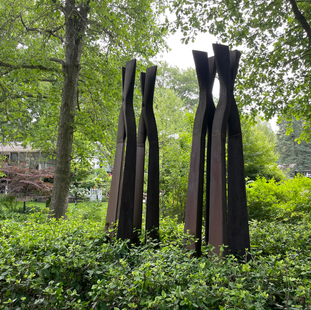MID-SIZED SCULPTURES
UNREALIZED PROPOSALS...
All rejections for an artist are difficult, but they are stepping stones toward developing one’s art and finding a direction to pursue. Wyrick feels gratitude for these opportunities:
DM Botanical Center
Fire & Water proposal
Wyrick entered this competition with her proposal of a sculpture for the Center’s planned water pool that would feature two bronze hollow spirals, each bearing water. These sculptures would produce sprays of water at designated times and would also carry gas lines that could be lighted to create flames for completion of the sculpture. This submission was not among those accepted, but Wyrick would have welcomed the challenge of realizing this concept.
Iowa Olympiad proposal
1981
This was the first Wyrick proposal accepted in a nationwide competition. The competition in 1981 was for the soon-to-be-built University of Iowa Carver Hawkeye Arena in Iowa City. There was a deep ravine on the south side of the building that divided the access routes to the arena from the south and east. Wyrick envisioned having a structure rising from the west side of the ravine that would have been made of CorTen steel, with four pillars of diminishing size to support its edge. On those pillars she proposed iron relief work that would relate to athletics, yet be applicable to life itself.
In addition, Wyrick proposed that a bank of yellow flowers be planted at the edge of the ravine, just south of the building itself to relate to Hawkeye colors of gold and black.
A nationally known sculptor, Lloyd Hamrol, was chosen and his limestone blocks, in a rising semicircular configuration on the east side of the ravine, close to the roadway, were installed.
Iowa Olympiad Proposal: the record of this proposal is only in a typewritten form. A later drawing of the concept was shown in an Art Student show, but was not kept.
Boston Back Bay proposal rejected all finalists
1985
By the time this proposal was made, Wyrick had answered many calls for proposals through various State Arts Registries and was asked in 1985 to submit a proposal for this national competition to be located in a Boston Back Bay transportation terminal.
On a trip to Boston, Wyrick had the opportunity to study the Boston site in depth and returned to Iowa City to develop the proposal that was to be the confluence of the four rivers in the area. The bronze sculpture would have been large enough to allow people to move through and under it.
Unfortunately, the selection committee changed its “call for proposals” two years after the deadline and rejected all five finalists they had earlier selected (including Wyrick) in 1987.
The committee decided to honor a local leader in the area of the terminal with his bronze statue rather than accept any of the more abstract artworks proposed by the finalists.
Grant Wood Art Colony Gate
2012 – 2015
In early 2012, Wyrick was asked to design a gate for the new Grant Wood Art Colony, in Iowa City at the north entrance to the Colony off of Burlington Street. With that in mind, Wyrick designed the gate with allusion to Grant Wood’s work, but most important to the design was that the tree has grown out of its boundary, demonstrating how Wood’s art has had widespread influence beyond his own work.
The commissioner supported the complex project from 2012 to 2015, including sketches, detailed and full-scale drawings along with plans for an automated gate. Wyrick’s planning included consultation with firms in St. Louis and definite plans with them for fabrication, finish work and installation.
When the commissioner unexpectedly and abruptly cancelled the project, Wyrick was unhappy to have to cancel with the small firms in St. Louis from whom she had been given so much technical advice and support and who were right on the verge of starting the complex process of fabrication.
COMMISSIONING SCULPTURE

-
The opportunity to be a part of the process and to watch the development of an artwork is one of the most rewarding and informative aspects of commissioning sculpture.
-
Individuals, as well as businesses and public agencies, may commission a work and the commissioned work does not have to be large to be commissioned.
-
A commissioned piece may be for an interior or an exterior space or can provide a link between the two.
-
Commissioned work may be scaled to the site and can involve the site and the place within the sculpture’s meaning.
The first step in commissioning an artwork is to select an artist whose work is liked or appreciated.
DURING THE PROCESS:
-
Confer and agree with the artist on site, budget, timeline and special considerations;
-
Receive from the artist one to several proposals for the artwork, either in drawing or small-scale form, from which a selection can be made;
-
Ask for a list of any preservation or conservation work that might be foreseen as the artwork ages along with references to services that can do that type of work;
-
Find enjoyment in the evolution of the artwork and celebrate!



























